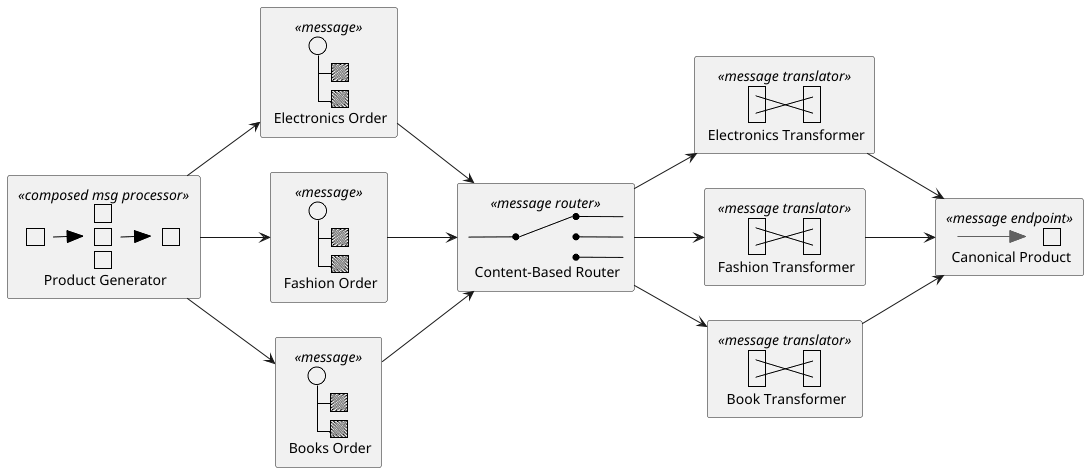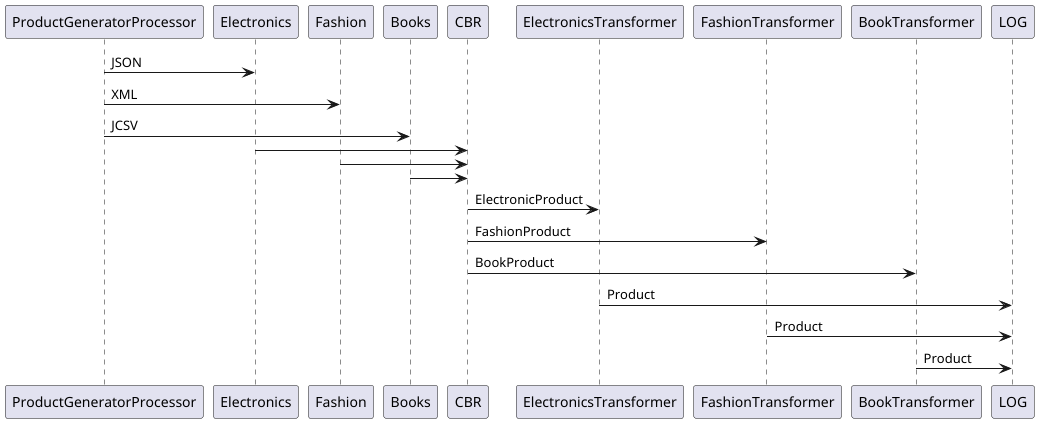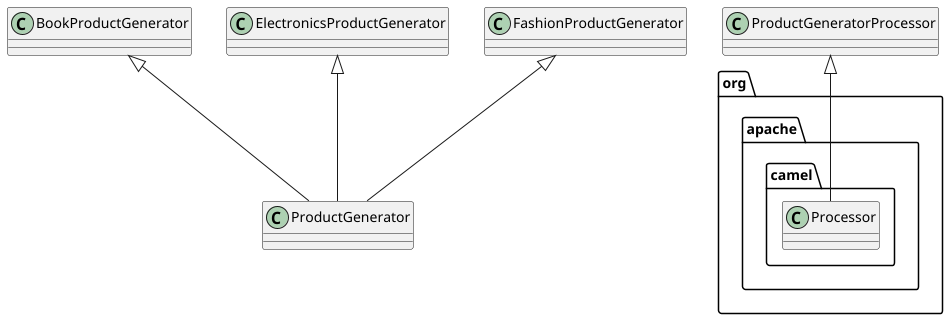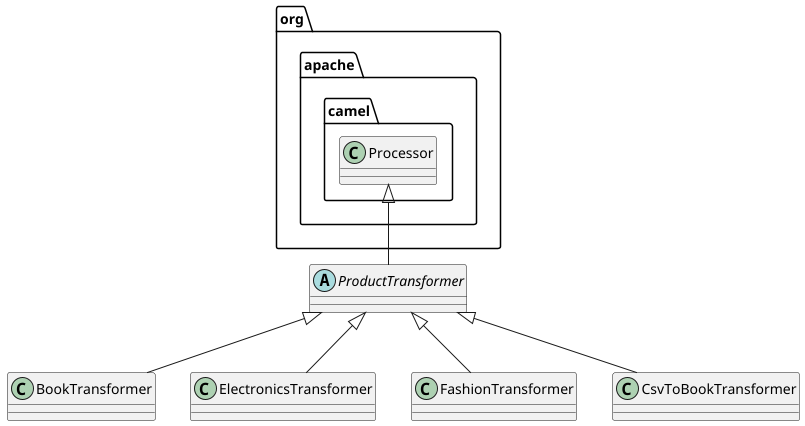EIP: Back to Fundamentals - The Canonical Data Model
This project demonstrates how to implement a simple, yet realistic, business case that uses the Canonical Data Model enterprise pattern.
Scenario
An online marketplace aggregates products from multiple suppliers with different data formats:
- Supplier A (Electronics): JSON format with nested specifications.
- Supplier B (Fashion): XML format with size/color variants.
- Supplier C (Books): CSV format with ISBN/author details.
All supplier formats are transformed to a canonical Product model for unified
catalog management, search, and display.
Sample Data Format for Supplier A
This supplier uses JSON as the data format.
{
"item_id": "ELEC001",
"name": "Gaming Laptop",
"cost": 1299.99,
"specs": {"cpu": "Intel i7", "ram": "16GB"}
}
Sample Data Format for Supplier B
This supplier uses XML as the data format.
<product>
<sku>FASH002</sku>
<title>Designer Jacket</title>
<price>299.50</price>
<variants>
<variant size="M" color="Blue"/>
</variants>
</product>
Sample Data Format for Supplier C
This supplier uses CSV as the data format.
isbn,book_title,author,retail_price
978-0134685991,Effective Java,Joshua Bloch,45.99
Architecture
The diagram below shows the software architecture of the implementation:

Everything starts with the ProductGeneratorProcessor which generates random
test products in JSON, XML or CSV notation. So, supplier A provides
electronics products in JSON format, supplier B fashion ones in XML format, as for
the supplier C, they provide books in CSV format.
The messages are generated on a time based frequency, one every 15 seconds, using
the timer Camel component. Once generated, these messages are passed to a CBR
(Content Based Router) which marshals each payload to its
Java corresponding record type, as follows:
- JSON messages, coming from the Supplier A, are marshaled to instances of
ElectronicsProductrecord type; - XML messages, coming from the supplier B, are marshaled to instances of
FashionProductrecord type; - CSV messages, coming from the supplier C, are marsheled to instances of
BookProductrecord type.
These Java record instances are further processed by dedicated processors, as follows:
ElectricsProductinstances are trasformed by theElectronicsTransformerprocessor toProductcanonical instances;FashionProductinstances are transformed by theFashionTransformerprocessor to canonicalProductinstances;BookProductinstances are transformed by theBookTransformerprocessor to canonicalProductinstances.
All these processors are subclasses of the abstarct class ProductTransformer
which implements the transformation general strategy, while bein specialized
by each concrete subclass.
Last but not least, the Product instances, ready to be shipped, are just
printed out in the Camel log file. In a real case, of course, they would have
been sent to a delivery channel.
Flow
The following sequence diagram is illustrating the implementation’s flow:

Key Components
- Generators. A set of generators are available in order to generate test data. They generate data in a supplier specific format, i.e. JSON for the Supplier A, XML for the supplier B and CSV for the supplier C. They all implement the
ProductGeneratorinterface. See the class diagram below:

- Transformers. A set of transformers responsible for mapping the specific data model to the canonical one. See the class diagram below:

- BookProduct. A record modeling a Supplier C specific product representation.
- ElectronicsProduct. A record modeling a Supplier A specific product representation.
- FashionProduct. A record modeling a Supplier B specific product representation.
- Product. A record modeling a canonical product representation.
- ProductCatalogRoute. The Camel main route. Its listing is shown below:
Here below is the listing of the ProductCatalogRoute class which defines the
Camel routes required by our implementation.
@ApplicationScoped
public class ProductCatalogRoute extends RouteBuilder
{
@Override
public void configure() throws Exception
{
from("timer:generator?period=15000")
.routeId("dataGenerationRoute")
.autoStartup(false)
.process("productGenerator")
.to("direct:processProduct");
from("direct:processProduct")
.routeId("dataProcessingRoute")
.choice()
.when(header("supplierType").isEqualTo("ELECTRONICS"))
.unmarshal().json(JsonLibrary.Jackson, ElectronicsProduct.class)
.process("electronicsTransformer")
.when(header("supplierType").isEqualTo("FASHION"))
.unmarshal().jacksonXml(FashionProduct.class)
.process("fashionTransformer")
.when(header("supplierType").isEqualTo("BOOKS"))
.unmarshal().csv()
.process("csvToBookTransformer")
.process("bookTransformer")
.end()
.to("log:canonical-product?showBody=true");
}
}
Sample output
... Body: Product[id=ELEC001, name=Gaming Laptop, price=1299.99, category=Electronics, attributes={specifications={cpu=Intel i7, ram=16GB}}, supplierId=SUPPLIER_A]]
... Body: Product[id=FASH002, name=Designer Jacket, price=299.50, category=Fashion, attributes={variants=[Variant[size=M, color=Blue]]}, supplierId=SUPPLIER_B]]
... Body: Product[id=ELEC001, name=Gaming Laptop, price=1299.99, category=Electronics, attributes={specifications={cpu=Intel i7, ram=16GB}}, supplierId=SUPPLIER_A]]
... Body: Product[id=FASH002, name=Designer Jacket, price=299.50, category=Fashion, attributes={variants=[Variant[size=M, color=Blue]]}, supplierId=SUPPLIER_B]]
... Body: Product[id=FASH002, name=Designer Jacket, price=299.50, category=Fashion, attributes={variants=[Variant[size=M, color=Blue]]}, supplierId=SUPPLIER_B]]
... Body: Product[id=978-0134685991, name=Effective Java, price=45.99, category=Books, attributes={author=Joshua Bloch}, supplierId=SUPPLIER_C]]
... Body: Product[id=FASH002, name=Designer Jacket, price=299.50, category=Fashion, attributes={variants=[Variant[size=M, color=Blue]]}, supplierId=SUPPLIER_B]]
Key Patterns Demonstrated
- Canonical Data Model: Transforms messages from a supplier specific format to the common canonical one.
- Message Transformer: Effectivelly performs messages transformation from a source to a target format.
- Content-Based Router: Routes messages to the appropriate Message Transformer.

